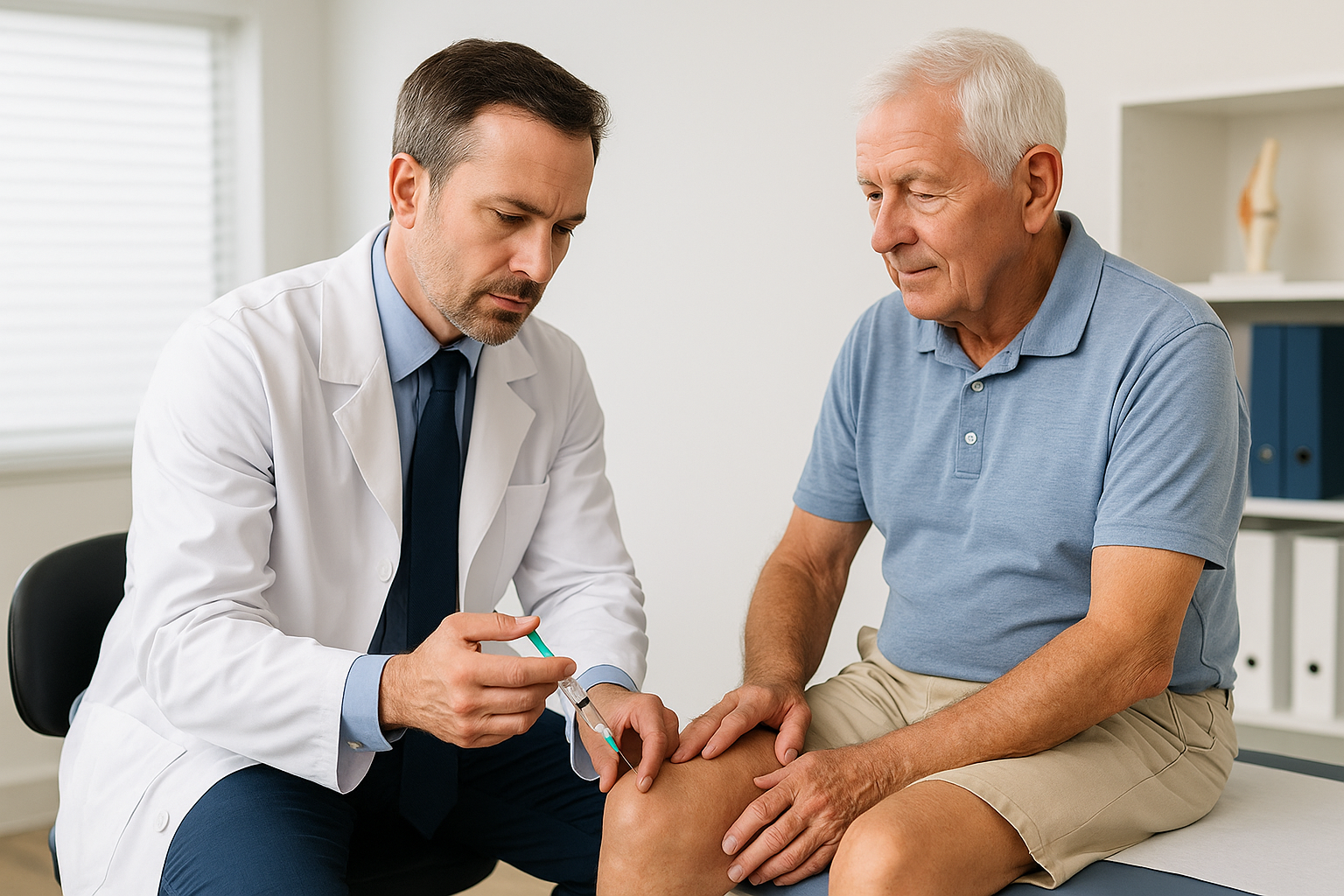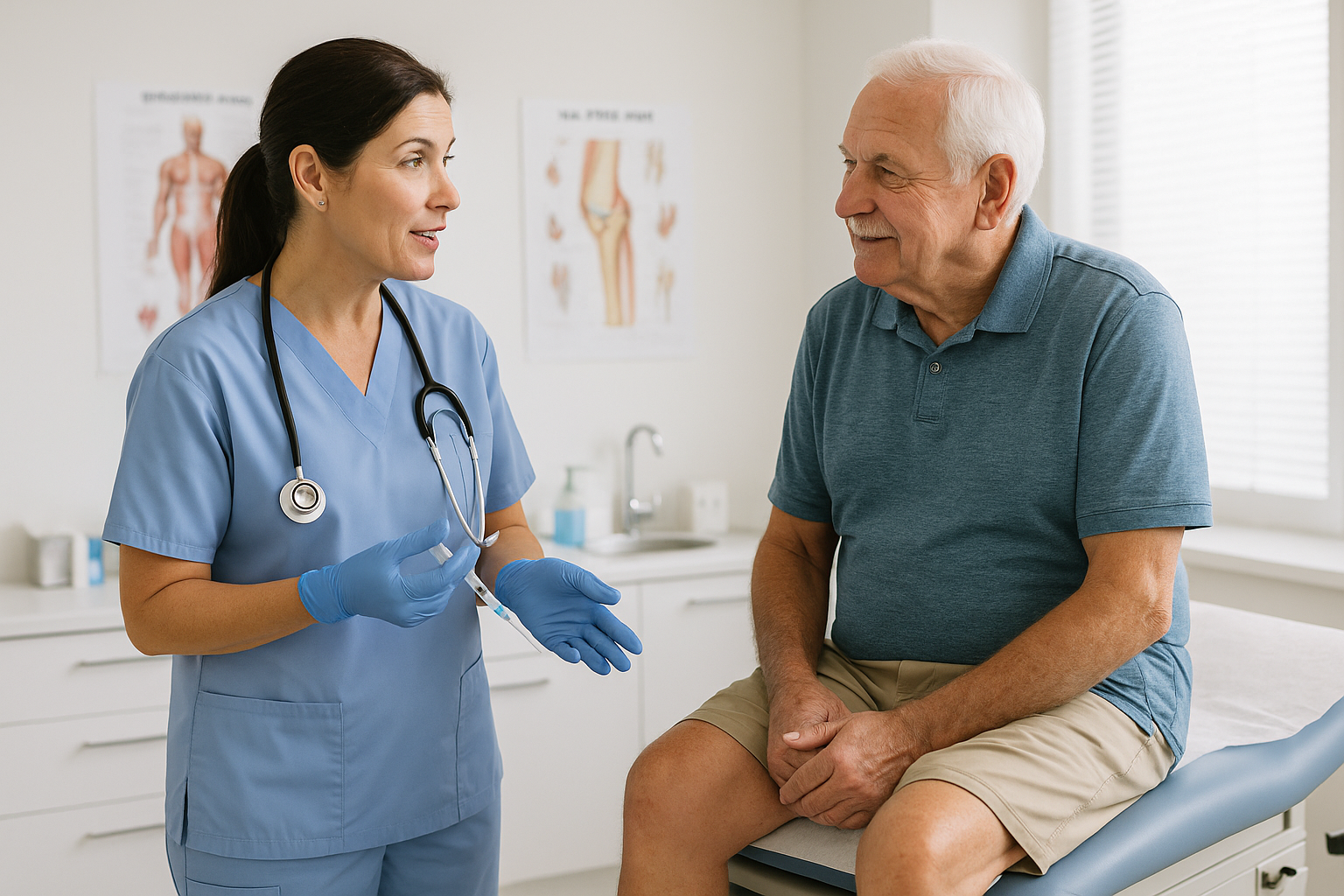The Ultimate Guide to Knee Injections

Knee injections are a medical treatment designed to reduce pain and improve function for people dealing with arthritis or chronic knee problems. Unlike oral medications that travel through the entire body, these injections go directly into the knee joint where the pain occurs. This targeted approach allows for faster and often more effective relief.
Most injections are done right in the doctor’s office and take only a few minutes. They use different types of medicine depending on your specific condition. Whether it’s inflammation, cartilage breakdown, or general joint wear, there’s likely an option that can help.
For many older adults, knee injections are a way to stay active without turning to surgery or strong pain pills. They are a safe, reliable option for managing symptoms and keeping up with daily life,from grocery shopping to spending time with grandkids.
These injections are often recommended for knee arthritis, a condition where the cartilage wears down and causes pain, stiffness, and swelling. Depending on your specific symptoms, your doctor might suggest corticosteroids for inflammation, hyaluronic acid for lubrication, or PRP to encourage healing.
What Are Knee Injections?

Knee injections are a non-surgical treatment where medicine is injected directly into the knee joint. They help reduce inflammation, add lubrication, and support healing, especially for people with what can be done for arthritis in the knee.
These injections deliver medication exactly where it’s needed, offering more targeted relief than oral painkillers. They’re commonly used when knee pain interferes with walking, standing, or sleeping. In many cases, they allow people to reduce or stop daily use of pain pills.
Knee injections are typically performed in a clinical setting and take only a few minutes. The treatment is tailored to each person’s needs based on their arthritis severity, age, lifestyle, and other health conditions.
Some common types include:
- Corticosteroids – Help reduce swelling and pain quickly, and may be used during flare-ups
- Hyaluronic acid knee injections – Act as a lubricant to help the joint move more smoothly
- Platelet-Rich Plasma (PRP) Therapy – Uses your body’s own healing cells to repair damaged tissue
While each option works a bit differently, they all share the goal of helping you move with less pain and improving your overall joint function.
Watch this quick video of Lee Trevino getting his knees injected to treat osteoarthritis.
Why People Choose Knee Injections for Arthritis Relief
If you live with arthritis in your knees, you know how tough it can be just to stand up or take a walk. Knee injections are often chosen to relieve:
- Stiffness and swelling
- Sharp or throbbing pain
- Limited movement
- Joint popping or clicking during movement
As arthritis progresses, the space between the bones in your knee narrows. This creates friction and pain. Knee injections help reduce that friction, relieve discomfort, and restore easier movement. They also reduce inflammation, which is one of the main causes of ongoing joint pain.
These injections can improve overall function, which means you may be able to return to hobbies like gardening, light walking, or even traveling without being held back by knee discomfort.
They’re especially helpful for:
- People not ready or eligible for surgery
- Those who don’t get enough relief from pills or creams
- Anyone wanting to avoid opioids or other pain medications
Knee injections are often part of a larger care plan. They can be combined with physical therapy, weight management, and light exercise to maximize benefits.
Many patients say knee injections give them a “second chance” at activities they thought they had to give up.
Types of Knee Injections Available
Different types of joint injections can provide relief based on your symptoms and needs. Your healthcare provider will help determine which type is best for your condition and goals.
Corticosteroid Injections
These powerful anti-inflammatory shots are often used for fast pain relief. They work well for short-term flare-ups but may wear off over time if used too often. Corticosteroids are typically used when there is noticeable swelling and redness in the joint. Relief often begins within a few days and can last from several weeks to a few months.
Hyaluronic Acid (Gel) Injections
Also known as viscosupplementation, this treatment helps replace lost joint fluid. It cushions the knee and helps it move more easily. Results build gradually and may last several months. This option is often ideal for people with moderate arthritis looking to delay surgery. It can take one to three injections to achieve full benefits, depending on the product used.
Platelet-Rich Plasma (PRP) Injections
Platelet-Rich Plasma, also known as PR,P uses your own blood, spun in a special machine to separate healing cells (platelets). These are injected into the knee to support natural healing. PRP is still growing in popularity and may be helpful for mild to moderate arthritis. Because it uses your body’s own cells, there is very little risk of allergic reaction. PRP is especially appealing to patients seeking a more natural solution.
What to Expect During a Knee Injection

Getting a knee injection is quick and safe when done by an experienced provider. Knowing what to expect can help ease any anxiety you may feel.
Preparing for Your Appointment
- Let your provider know what medications you take
- You may need to stop blood thinners temporarily
- Wear loose, comfortable clothing so your knee is easy to access
- Don’t apply any lotions or creams to the knee area before your visit
It’s also helpful to write down your symptoms and bring a list of questions to your appointment. The more information your provider has, the more personalized your treatment can be.
The Injection Process Step-by-Step
- You’ll sit or lie in a comfortable position
- The injection area is cleaned and sterilized
- Your provider gently inserts the needle and injects the medicine
- A small bandage is placed over the site
The entire procedure usually takes less than 15 minutes. Many people report minimal discomfort and say it feels like a pinch or slight pressure. If you’re nervous, your provider may offer a numbing spray or local anesthetic.
Aftercare and Recovery Tips
- Rest your knee for the next 24 hours
- Use ice if there’s mild soreness
- Avoid high-impact activity for a day or two
- Drink plenty of water and keep the leg elevated if swelling occurs
You should begin to notice improvement within a few days. Some injections, like gel or PRP, take longer to work and may require a few sessions. Be patient, and follow up with your provider as recommended.
How Knee Injections Can Help Delay Surgery
For many people, knee injections provide enough relief to avoid or postpone disadvantages of knee replacement surgery guide. They:
- Improve comfort and mobility
- Support joint health
- Give you time to try other treatments like physical therapy
- Allow older adults to remain independent longer
Surgery isn’t always the right solution for everyone. Some people may not be good candidates due to age, medical conditions, or personal preference. Others simply want more time to explore non-invasive options. Injections help manage pain while buying valuable time.
Delaying surgery isn’t just about avoiding the operating room—it can mean fewer risks, shorter recovery, and more control over your care plan. Many patients use this time to strengthen the muscles around their knees through light exercise, which can enhance injection results. It also gives you a chance to maintain an active lifestyle with fewer limitations.
Are There Any Risks or Side Effects?
Knee injections are generally safe, especially when done by trained professionals. However, like any procedure, they can have side effects.
Possible but Rare Risks
- Infection
- Bleeding
- Joint irritation or allergic reaction
- Flare-up of temporary pain post-injection (usually resolves in 24–48 hours)
Your provider will take every precaution to reduce risks. This includes using sterile equipment, checking your medical history, and carefully choosing the right injection site and method.
Common Side Effects
- Mild pain or swelling at the injection site
- Temporary stiffness
- Bruising around the injection area
These symptoms usually fade within a day or two. You can ease discomfort by applying ice, resting the leg, and avoiding strenuous activity. Be sure to contact your provider if symptoms persist or worsen.
Is It Time to Consider Knee Injections?

You might be ready for knee injections if:
- Knee pain affects your daily life
- Medications and home treatments don’t help
- You’re not ready for surgery but want long-term relief
- You want to stay active and independent longer
Ask yourself these questions:
- Am I avoiding activities because of knee pain?
- Do I take pain medication regularly just to get through the day?
- Has walking, climbing stairs, or sleeping become more difficult?
If you answered “yes” to any of these, it may be time to speak with a specialist. Knee injections can help reduce pain, improve your quality of life, and keep you moving.
Talk with your healthcare provider about your pain levels, what you’ve tried so far, and how knee injections could fit into your treatment plan. Many people wish they had started sooner once they feel the benefits.
Take the First Step Toward Knee Pain Relief
If you’re tired of living with constant knee pain, Arthritis Knee Pain Centers is here to help. Our Visually Guided Viscosupplementation Gel Injections offer precise, non-surgical relief—without downtime, opioids, or surgery.
Over 60,000 patients have found comfort through our advanced treatment. Let us help you take your first step toward a more active life. These gentle injections are performed using advanced imaging, so they go exactly where they’re needed.
Don’t wait for your pain to get worse. Take back control and start your journey toward better knee health.
Schedule a No-Charge, No-Obligation Knee Screening today and see how we can help you feel better and move more easily
Schedule a No Charge, No-Obligation Screening.
Call 833-300-5633 Now
Or Use Our Appointment Request Form!
